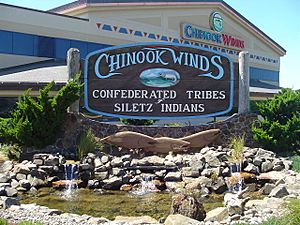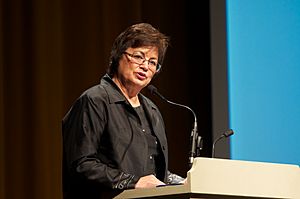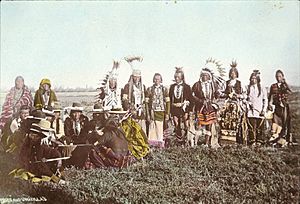Confederated Tribes of Siletz Indians facts for kids
| Total population | |
|---|---|
| 5,600 (2020) | |
| Regions with significant populations | |
| Languages | |
| English | |
| Related ethnic groups | |
| Athabaskan peoples, southern Interior Salish peoples |
The Confederated Tribes of Siletz Indians is a group of more than 27 Native American tribes and bands. They are "federally recognized," which means the United States government officially recognizes them as a sovereign nation.
These tribes once lived on a huge amount of land. This land stretched from northern California to southwest Washington. It also went from the Cascade Mountains to the Pacific Ocean. After the Rogue River Wars, these tribes were moved to a new home. This new home is now called the Siletz Reservation. The tribes spoke at least 11 different languages.
Contents
What Does "Siletz" Mean?
The name of the confederation comes from the Siletz River. This river flows near the main area of the reservation. The word siletz means something that is coiled like a rope or a snake. This describes how the river winds through the mountains to the ocean. The confederation also includes parts of the Siletz people. They are a Coast Salish people who joined the larger group.
Who Are the Siletz Tribes?
The Confederated Tribes of Siletz Indians is made up of many different tribes and bands. Here are some of them:
- Tillamook (including Siletz, Salmon River/Neachesna, Nestucca, Nehalem, and Tillamook Bay people)
- Alsea (including Yaquina)
- Chinook (including Wakhiakum, Multnomah, and Clatsop)
- Coos (including Hanis and Miluk)
- Kalapuya (including Santiam, Tualatin, Yamhill, Yoncalla, and Marys River band)
- Lower Umpqua and Siuslaw
- Molalla
- Shasta (including Klamath River people)
- Rogue River peoples (including Shasta, Upper Rogue River Athapaskan peoples like Applegate and Galice Creek, and Lower Rogue River Athapaskan people)
- Klickitat
- Takelma (including Dagelma, Latgawa, and Cow Creek)
- Oregon Athabaskans (including many bands from southwestern Oregon like Chetco, Tolowa, and Upper Umpqua)
History of the Siletz Tribes
The Confederated Tribes formed from the remains of about 28 different tribes. These tribes were originally from the coast and other parts of Western Oregon.
Life After the Wars
After the Rogue River Wars in 1855–56, most of these people were forced to move. They were sent to the Coast Indian Reservation, which later became the Siletz Reservation. The idea was for them to become one unified tribe.
The Coast Reservation was very large at first, about 1.1 million acres. But over time, its size was greatly reduced. In 1865 and 1875, about three-quarters of the land was taken away. Later, in 1894, individual tribal members were given small pieces of land. The rest of the land was sold off. By 1912, many of these lands ended up being owned by non-Native people.
The Termination Act of 1954
In 1954, a new law called the Western Oregon Indian Termination Act was passed. This law ended the government's official relationship with many Native American tribes. For the Siletz, it meant the government stopped overseeing their lands and services.
Almost all the remaining Siletz lands were sold. Only 39 acres, known as Government Hill, were kept. The money from selling the timberland was given to tribal members.
Working for Restoration
During the 1960s, Siletz tribal members started working to bring their community back together. They worked to restore their tribal cemetery on Government Hill. They also strongly asked the government to recognize them again as a federal Native American tribe.
In 1974, the first bill to restore their status did not pass. Then, in 1975, Senator Mark Hatfield introduced another bill. He said the Siletz people were "ill-prepared" when their federal status was ended. He felt they were "tossed abruptly" into a new way of life. This bill also did not pass.
Finally, in May 1977, a new bill was introduced by Senator Hatfield and Senator Bob Packwood. This bill passed the United States Senate in August 1977. It then passed the House of Representatives in November 1977. President Jimmy Carter signed it into law on November 18, 1977.
Today, about 5,600 descendants are members of this tribe. Their main home is on the Siletz Reservation. It is located along the Siletz River in the Central Oregon Coast Range. This is about 15 miles northeast of Newport, Oregon.
Important Moments in Tribal History
- 1977: The Confederated Tribes became the second tribe in the U.S. to have its federal status restored. This meant they were again a sovereign government.
- 1979: Tribal members created and adopted their own constitution.
- 1979: The town of Siletz voted to return about 36 acres of land to the tribe. This land was the original site of the Siletz Agency, "Government Hill."
- 1980: The Siletz Reservation Act was signed into law. This returned about 3,660 acres to the Siletz Tribe as their first restored reservation land.
- 1994: The Tribe voted to lower the "blood quantum" requirement. This allowed more new members to join the tribe.
- 1995: The first "Run to the Rogue" took place. Tribal members carried an eagle flag staff from Siletz to Agness, Oregon. This is Oregon's longest relay race on foot.
- 1995: The Siletz Tribe opened the Chinook Winds Casino and Convention Center. It is a large building that overlooks the Pacific Ocean in Lincoln City, Oregon.
- 2005: A hotel next to the Chinook Winds Casino was bought and added to the casino.
- 2016: A bill passed in the U.S. House of Representatives. This bill made property within the original Siletz Reservation boundaries officially "on reservation" land.
Organization and Location
The Confederated Tribes have 5,600 enrolled members. About 70% of them live in Oregon. Only about 8% live near the 3,900-acre reservation.
The tribe owns and manages about 16,000 acres of land in total. About 4,000 acres of this is the Siletz Reservation. It is located along the Siletz River in central Lincoln County, Oregon.
The tribe also owns and runs several businesses. These include the Chinook Winds Casino and Convention Center. They also have the Chinook Winds Golf Resort and an RV park. Other businesses include the Siletz Gas & Mini Mart.
The tribe also owns and runs the Siletz Community Health Clinic. There are plans to make the clinic much larger. The tribe is also working to get its old treaties with the United States recognized. They are also trying to get back the remains of their ancestors and tribal artifacts.
The current Tribal Council includes Chairman Delores Pigsley. Other members are Vice Chairman Bud Lane, Secretary Sharon Edenfield, and Treasurer Robert Kentta.
The tribe's Public Information Office publishes a monthly newspaper called Siletz News.
Cultural Activities
Artifacts and historical documents are kept and shown at the Siletz Tribal Cultural Center. This center is located on Government Hill. Cultural Programs Staff take care of these important items.
The Tolowa language is taught as a common tribal language. Classes for the Athabaskan language have been taught at the Siletz Valley Charter School.
Every year, on the second weekend in August, the tribe hosts its annual Nesika Illahee Pow-wow.
For hundreds of years, a special dance called the Feather Dance (or Nee-dash) has been held. It lasts for 10 nights during the summer and winter solstice.
A newer tradition has also started. During the winter solstice, Siletz dancers and singers visit the Tolowa tribe's dance house in California. During the summer solstice, Tolowa dancers visit the Siletz people's dance house.
Population Information
It can be hard to find exact records of the Siletz tribal population from long ago. Here is a partial list of tribal groups before they were forced onto reservations in the mid-1800s:
- Upper Rogue River or Shasta Tribe:
- John's Band: 172 people
- George's Band: 222 people
- Joseph James's Band: 160 people
- Coastal Tribes:
- Joshuas's Band: 179 people
- Choallie's Band: 215 people
- Totoem's Band: 202 people
- Macanotin's Band: 129 people
- Shasta Costa: 110 people
- Port Orford (a Qua-to-mah band): 242 people
- Upper Coquille: 313 people
Languages Spoken
The ancestors of the Confederated Tribes spoke at least 11 different languages. Here are some of them:
- Salishan languages
- Shastan languages
- Penutian languages (a proposed group of languages)
- Chinookan languages
- Kalapuyan languages
- Takelma
- Plateau Penutian languages
- Sahaptian languages
- Sahaptin (Klickitat dialect)
- Molala
- Sahaptian languages
- Coast Oregon Penutian languages (a proposed group)
- Na-Dene languages
- Athabaskan languages
- Lower Rogue River (or Tututni)
- Upper Rogue River (or Galice-Applegate)
- Upper Umpqua (or Etnemitane)
- Tolowa (or Siletz Dee-ni)
- Athabaskan languages
The Siletz Dee-ni language is very important to the tribe. For a while, there was only one person who spoke it fluently. But now, the tribe has a language revival program. They have classes in different offices and at the Siletz Valley school. Many younger speakers are now learning the language. Some even text each other in Siletz Dee-ni!
Notable Siletz People
- Peter "Last Walking Bear" DePoe: A drummer for the band Redbone.
- Sister Francella Mary Griggs: She worked hard to help the tribe get federal recognition again.
- Mary "Dolly" Fisher: An activist who helped restore federal recognition for the Siletz Tribes. She won awards for her leadership. She also named the tribal casino "Chinook Winds."
- Calvin Leroy Van Pelt (1924–2011): A businessman and respected tribal elder.
- Delores Ann (Lane) Pigsley: One of the longest-serving tribal leaders in the United States. She is still the Siletz Tribal Chairman as of 2020.
See also
 In Spanish: Tribus confederadas de indios siletz para niños
In Spanish: Tribus confederadas de indios siletz para niños




